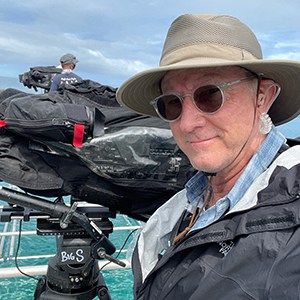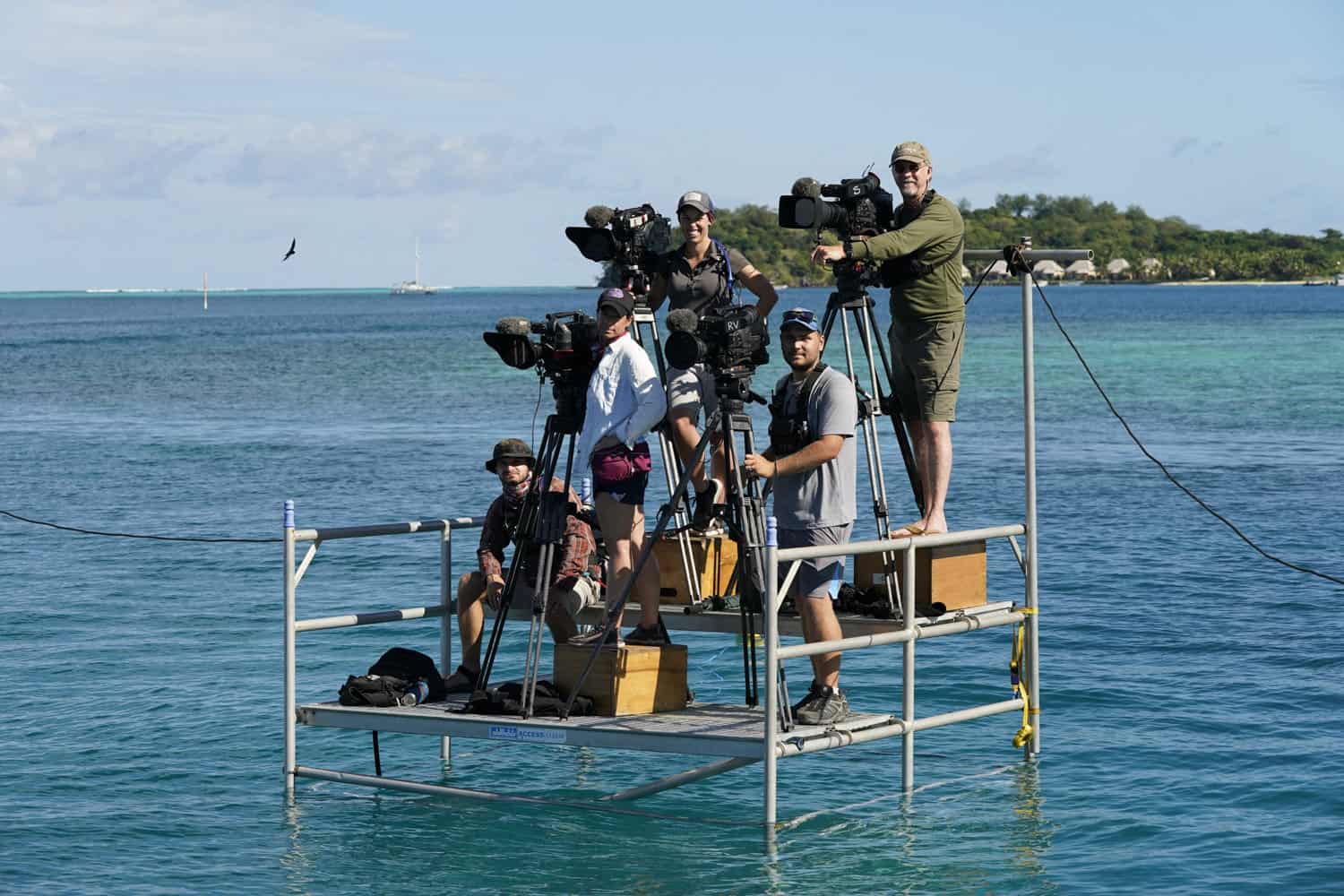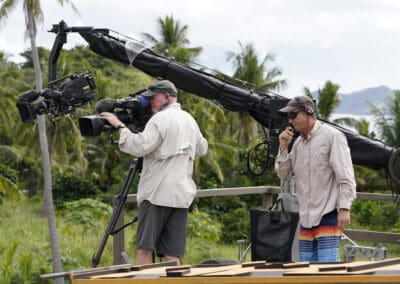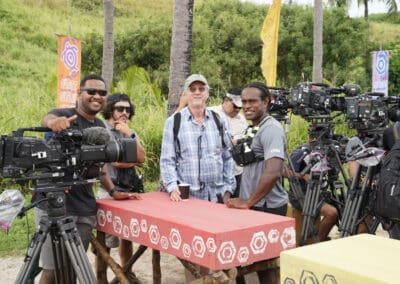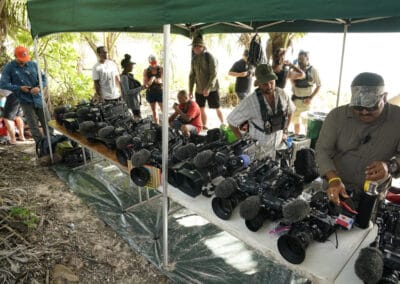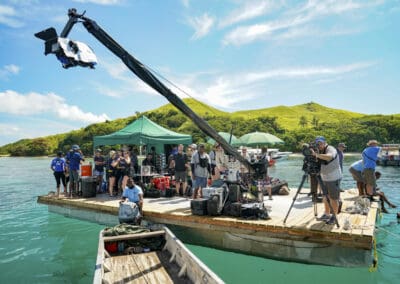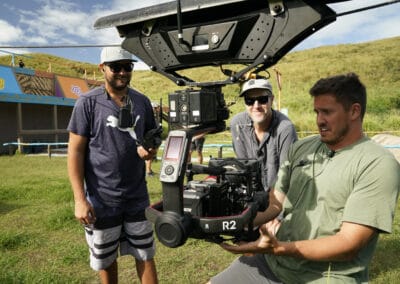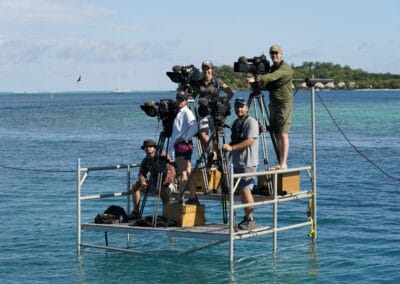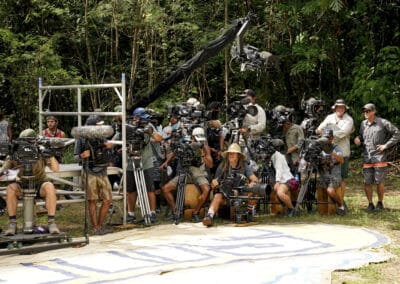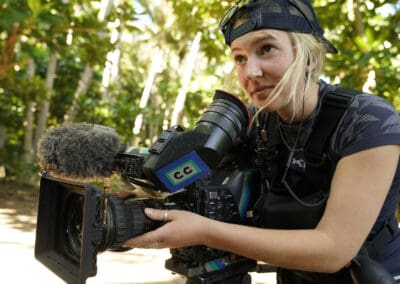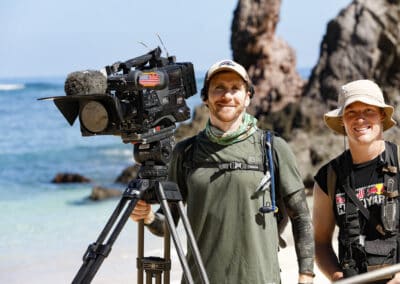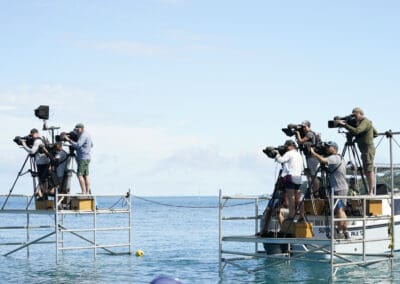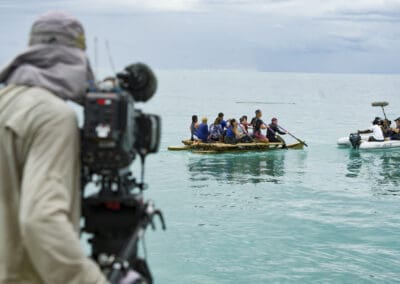SURVIVOR Seasons 41 and 42: Beyond Surviving
Part I
By David Frederick, SOC
Survivor is the American version of the international Survivor reality competition television franchise, derived from the Swedish television series Expedition Robinson created by Charlie Parsons, which premiered in 1997. The Emmy Award–winning American series premiered on May 31, 2000, on CBS. It is hosted by television personality Jeff Probst, also an executive producer along with Mark Burnett and the original creator, Parsons.
The show places a group of strangers in an isolated location, where they must provide food, fire, and shelter for themselves. The contestants compete in Challenges, including testing the contestants’ physical abilities like running and swimming, or their mental abilities like puzzles and endurance challenges, for rewards and immunity from elimination. The contestants are progressively eliminated from the game as they are voted out by their fellow contestants until only one remains and is given the title of “Sole Survivor” and is awarded the grand prize of US$1,000,000. (Source: Wikipedia)
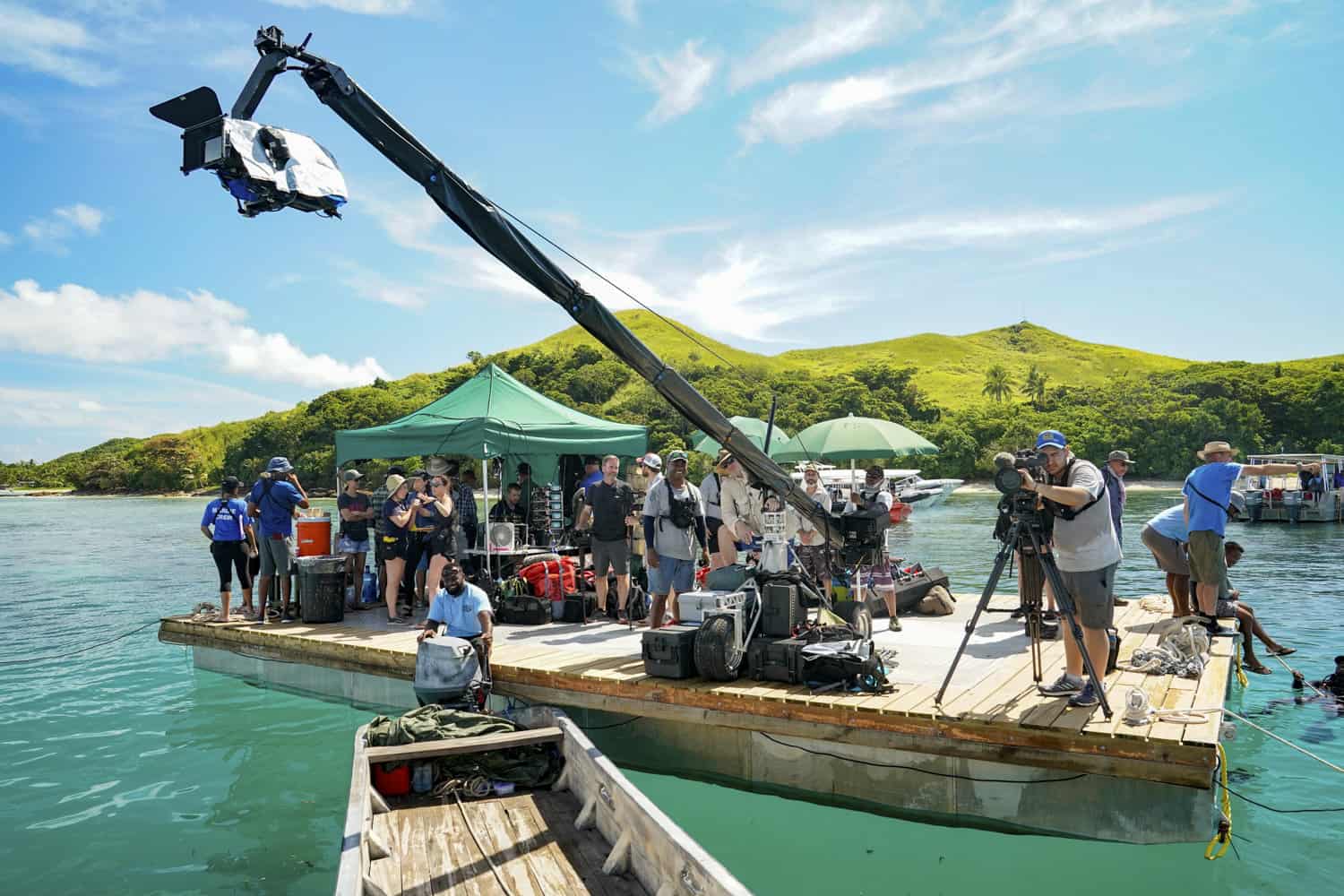
Day 5 from Survivor 41. Photo by Robert Voets/CBS Entertainment 2021 CBS Broadcasting, Inc.
It was mid-March of 2021, the pandemic was seeming to wind down somewhat but the work wasn’t as forthcoming as it was in the time before COVID-19 became the global threat to humanity. I was thrilled to get a notification from Matt Valentine, SOC, asking of my interest to work on Survivor in Fiji. It wasn’t a trick question! He couldn’t go and was passing my name to production if I was interested and available. I answered yes once he told me it was with the same director I had worked with on another adventure show, Love in the Wild (see article in SOC Camera Operator Spring/Summer 2012).
Director David D. Dryden is a great guy, a great pro and great fun to work with. David started on Season 3 of Survivor in 2001. I was in touch with him via texts and a few hours later I had my start paperwork completed electronically and I was headed to Fiji two weeks later. After a Fijian government imposed two-week quarantine in Port Denarau’s Hilton Hotel in Fiji mainland, 150 travelers from the LAX flight boarded a bus to a ferry to end up on Mana Island, Fiji, for the next two-and-a-half months for Survivor Seasons 41 and 42.
The reason that I wanted to share my experiences with you in this article is the incredibly large global pool of talented and dedicated professional camera people working on Survivor that defied any expectation I had. Survivor is a show with a magic bond existing amongst the hundreds of hardworking crew members, brought together to create an experience for the chosen contestants, creating an enduring television production for millions of devoted fans. The camera, audio, G&E, art, production, unit, medical, and staff people are from many countries—all harmonious in their collaborative efforts to tell a captivating story. Knowing that this will be read by interested parties at every level of experience and expertise, is the attraction to contribute to the SOC publications and educational efforts for many of us. I feel it’s important to share these illuminating conversations with you and my hope is that you come away with a better understanding of the community that we are all a part of.
I was hired to fill in for a camera operator friend, Derek Hoffmann, that I knew from ten years ago on NBC’s Love in the Wild. Due to a pressing family emergency he had to decline returning to Survivor as one of the “Challenge” long lens camera operators. Derek has worked on Survivor for many years, and I was honored to fill in for him.
During the last few days of the Fiji-mandated quarantine, passing the swab tests, we were permitted to exercise outdoors as a group of the 160 LAX flight Survivor employees for an hour twice a day. During that escape from our hotel rooms, a gigantic group meet-and-greet, I was glad to make the acquaintance of the other long lens challenge camera operator, and soon to become my new friend, Kevin Garrison. Kevin makes his living as a sports camera operator for NFL, NBA, NHL, and the PGA. Kevin is one of those seasoned veterans of the long lens who is able to follow a golf ball as it sails through the space on its way to the green and the cup. He shared a great deal of insider pro tips and I am extremely grateful. We were tasked with the close-ups of the contestants as they made their way through the Survivor challenges, competing for Immunity Challenge at Tribal Council or a Reward Challenge. These Challenges have become legendary for the viewers and were a welcome arena for the returning squad of Challenge operators, of which I was to become after my initiation to this cadre of tightly knit professionals.
Equally exciting for me was to meet the other camera operators who were filming the crucial reality portion of the Survivor program. These “camera on shoulder nearly all day” storytellers are very experienced pros who have been, for the most part, returning veterans of Survivor who look forward to each day’s adventure at the Tribe Camps, closely linked with their audio person and their AC. It’s a symbiotic team that presses to the edge every day in their quest to artfully capture the unpredictable behaviors of their subjects, the contestants, a completely varied and diverse group of people with one purpose, to be the sole winner of the million-dollar prize.
I could not help but to think that I must share the perspectives of this wonderful collection of some of the best professional camera operators from around the world with the SOC membership. This is such a large, diverse, and accomplished group of operating talent gathered with such dedication and passion to do the work eagerly and share the experience together year after year. I sat and spoke with quite a few of them, both in the Challenges and the Reality groups, balancing the seasoned returning camera operators and the ACs who had now made their way to operator by putting the time in, and gaining the know-how firsthand. It’s a remarkable group, so very dedicated to the global ensemble collective of telling the story of Survivor in exotic locations around the world for 21 years.
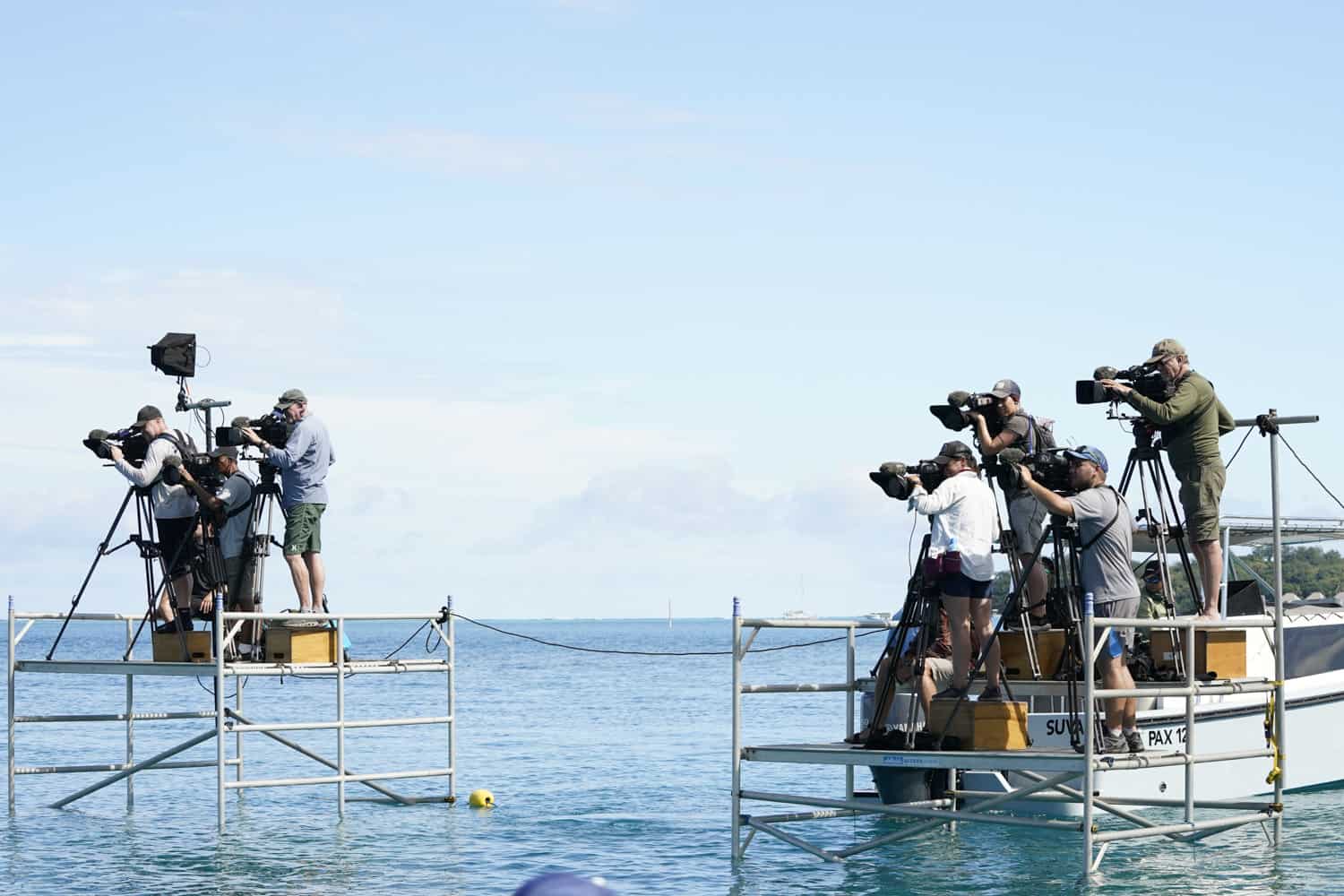
Day 15 of Survivor 42. Photo by Robert Voets/CBS Entertainment 2021 CBS Broadcasting, Inc. All Rights Reserved.
THE SURVIVOR FAMILY
Host Jeff Probst, an extremely affable man who has been with the show since its inception, fondly portrays the battalion of souls who make the Survivor show happen as a family. I completely concur. Arriving at LAX as we assembled for check in and departure, it became obvious when I witnessed the affection and familiarity of smiles and embraces by everyone as they saw each other once again, in all the departments. It was reminiscent of a large family picnic, or wedding gathering with unfettered love and affection for each other. Once again, Jeff Probst is one of the prime reasons for this. He sets the tone, and, as an executive producer, he has total sway and say about every detail of the production. Jeff is gracious, kind, knows everyone’s name, constantly expresses his gratitude, and acknowledges the good and hard work being done. He is a true leader and all follow gladly.
I began my conversations about Survivor with Challenge camera operator John Tattersall, born in Tortola, BVI, educated in England, and has been involved with Survivor since Season 2. John is the one handheld “CamOp” on the challenges. His historical reckoning was so informative for me in our lengthy conversations as I tried to understand and become one of the Survivor family. John explained, “On Survivor, there are families within the bigger family, the crew is big enough that there are lots of little groups, some that I haven’t had conversations with in years, but the show has been a very big part of my life, and when you’re back with your close friends on the show, who you may not have kept in touch with, you reconnect, you’re straight back at it, like nothing ever happened meantime. When I come here, it’s like we are a band of brothers, even though the percentage of gender is evolving so there is a growing mix of sisters, as well.”
Kevin Garrison, my colleague on the 40x long lens Challenge camera operator, has been on Survivor since Season 3. He says that there is very much a Survivor family, like on his other jobs for the 30 years that he has worked on the various sporting world shoots. “The Survivor family is a very big family and in fact, there have been families started as a result of working on Survivor.” Kevin mused that, “There may be as many as 63 children brought into this world as a result of the parents meeting on Survivor.”
Rodney Chauvin, a painter and Reality camera operator from New Orleans, Louisiana, started on the seventh year of Survivor and had this observation: “Survivor is like a well-run military operation. It’s incredible how big the show is, how many people work in camera, art, production, unit, and even the marine department. We have 20 to 30 boats—it’s unbelievable how amazing this big machine of a show is. For me it’s like a family reunion each year, I just wish my wife and kids could be here as well. There are lots of cool relationships and friendships here, we all look forward to seeing each other.”
Because of the protected nature of the show’s content, and having signed an NDA in earnest, in this article I am more interested in exploring the culture of the camera crew behind the scenes as it is something viewers of the show will never get a glimpse of. So, one of the questions I’m asking both the Reality and Challenge camera crew members is how did they get a foothold in this highly desired family of camera and crew people?
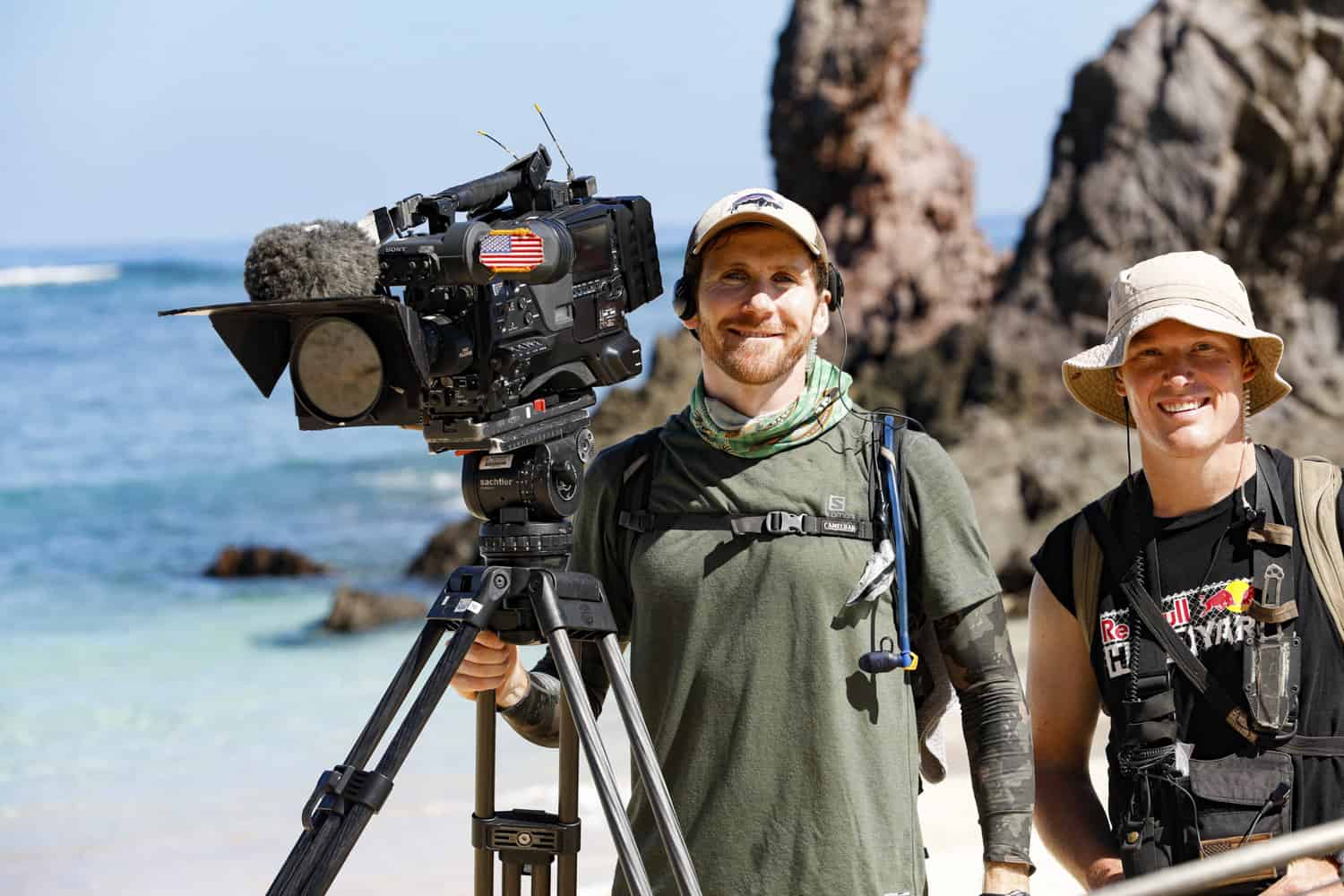
Day 1 on Survivor: Ghost Island, on the CBS Television Network. Photo: Robert Voets/CBS Entertainment 2017 CBS Broadcasting, Inc.
STARTING OUT: GETTING A JOB ON SURVIVOR
Peter Wery, the DP and A crew camera operator of the Reality camera operator crews, explained his journey to get hired on the show, “I tried to get on the show for two years. Every three months I would send them an e-mail and the response was always the same ‘Sorry, no new spots open.’ Then, for Season 6 in the Amazon, they needed a wildlife and EPK shooter, I got the job. They loved my work and I scored the dream job next season as a reality shooter on Survivor: Pearl Islands, Season 7. Now, as we just finished Season 42, I haven’t missed a single season. The job is awesome and the production team treats us all super well.”
Because there is such a symbiotic relationship between camera and sound, and since I made a great new friend, I spoke with one of the longest serving audio operators of Survivor, Heron Alencar, who lives in Brazil, and spoke of his start on the show, “I started on Survivor in 2004. I think it was either Season 9 or 10, the fourth year. I started with this world of reality filming with the first seven seasons of The Amazing Race. After the seventh season on Race, I went to Survivor in the same year. I started first in Panama in 2004, 17 years now.”
I asked him his perspective of how the camera sound duo operates, “In a documentary or a reality show, which is quite like a documentary, you are beside your camera and you become kind of a shadow of the operator.”
“With the camera aspect of the work, the sound is always trying to follow the camera, so I always have the operator in my sight, they move, I move with them. The sound man has a very good idea what the lens is shooting. Before, when it was film, it was easy because there was the stick on the zoom, when it was up it was wide, when it was down it was a tight lens. That’s exactly where to put your microphone to get the best sound. Nowadays, with digital and zoom motors, the difference is more of the angle of the camera. When you see the lens pointing down you know that is going to be wide and when it points up, it’s a tight shot. Just by seeing which way it’s pointing. That’s the way we know the shot, and then we are always looking at the operator, and not just one, but several when using multi cameras. Which makes it a challenge because you have to be very aware with the multiple cameras doing cross coverage. It’s quite tricky, it is a simple job, but it’s tricky because, for example, here we have sometimes seven cameras covering the same event. Several cameras and audio so it’s each one is covering something and you make sure that you’re not in anybody’s shot.”
“When dealing with a large group of contestants, just after a tribal merge there are about 12 people to cover, and it is a bit complicated at the beginning. We try to establish the arrival so everyone has an assigned point, but afterwards we are on our own. When they come and speak their thoughts back at the camp, it’s a free for all, each camera follows the conversation, we try to be organic. If one camera team is closer to someone, it goes there, it is a little bit tricky, especially when there are 12 contestants, it can sometimes become a mess.”
Kevin Garrison on the Challenge crew shared his origin on Survivor, “I was shooting on Eco Challenge many years ago, in the early 2000s, in Borneo. I was sent off to cover a leg of the bike race deep in the jungle. We had been filming all day and there was a short break so my audio guy pulled out a hot plate and heated up some noodles with hot water. It was getting dark and it smelled so good. It was very still out and all of a sudden the trees started to move, but not by wind. It became very frightening. The guy making the pot of noodles ran to the car and locked himself inside. He was so scared. I kept filming the trees and kept rolling, and rolling. The tree rustling got more and more intense and all of a sudden, a very big orangutang pops out and does a big MGM-style ROAR right into my lens. I was scared. He came over to us and I felt sure he was going to drop down and kill us. We didn’t know what was next but he ended up disappearing back into the jungle.”
“The next day, it was said over the radio to Burnett, the creator of Eco Challenge and Survivor, that I had filmed an orangutang in the wild. Mark Burnett then sent a chopper to our camp to pick me up with the footage, taking me to a little cabin to show him. He walks in and I show him the video and he starts telling me how epic it was, amazing to not only see an orangutang in the wild, but to film it. It made it into the show, it was one of the first wild shots that he got that year.”
Kevin continues, “Mark called me after that to ask me to work on the first Survivor, but I had a commitment to the PGA tour schedule that year. I couldn’t turn down guaranteed work at the time, not knowing anything about this new show. It was a year after that when I was asked by the early Survivor director, Cord Keller, after another shoot, to join Survivor for Season 3. That was my start on Survivor.”
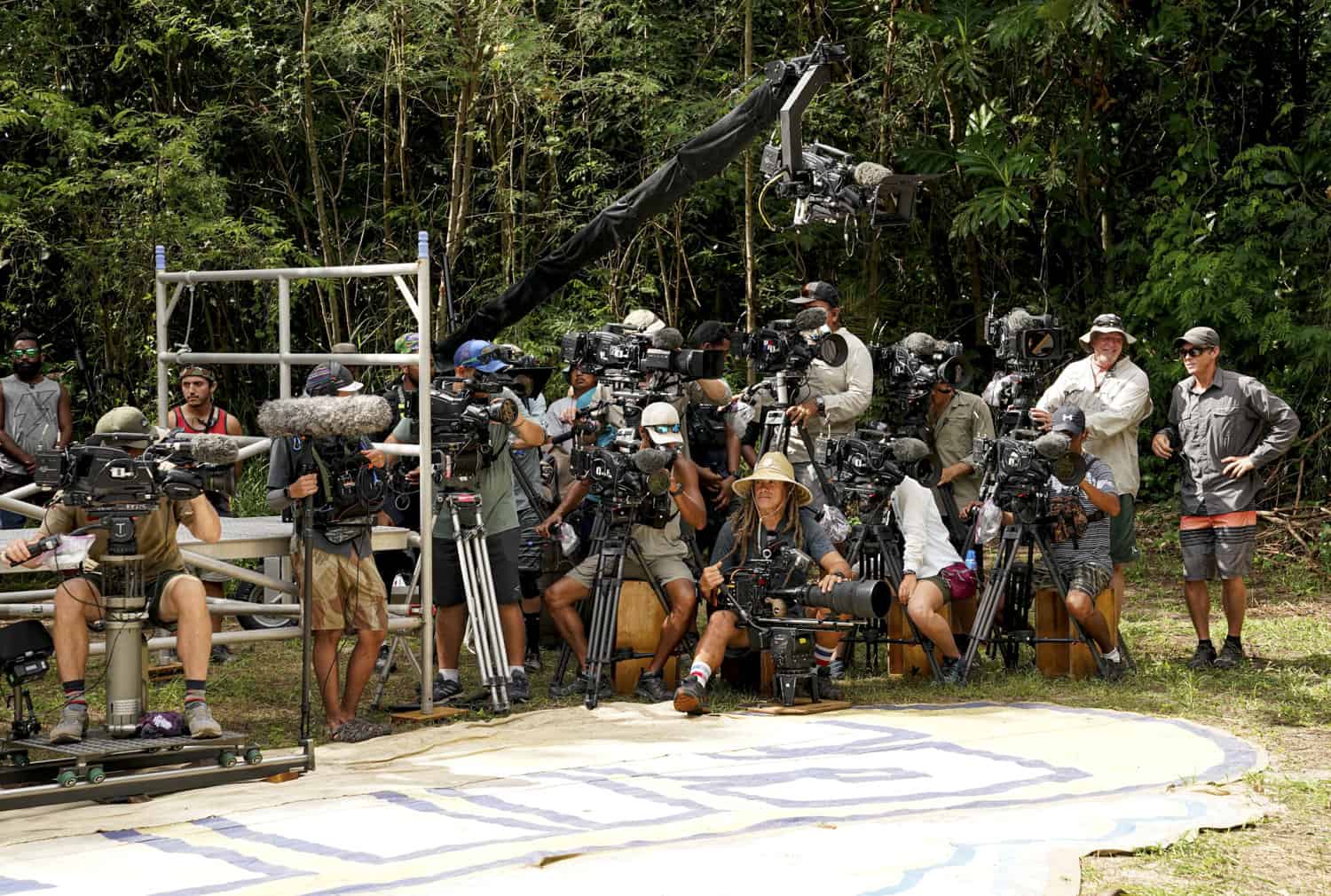
Day 19 from Survivor 41. Photo by Robert Voets/CBS Entertainment 2021 CBS Broadcasting, Inc.
In addition to his work on the long lens, Kevin oversees the setup of the contestant’s positions on the frequent Tribal Council shoots. It is a beautifully designed theatrical style set with preset exact lighting, fire effects, torches, two jibs, a dolly camera, and up to 12 more cameras cross shooting and hidden from each other covering the biggest contestant event nights. Kevin pointed out, “Tribal Council is a part of the show where the contestants vote someone out and where we snuff out their torch and they go home. There’s many cameras with a lot of responsibilities. Mine is one of the two to provide all the close-ups and talking singles during tribal, as you know because you did the other camera for two seasons. I also have a little responsibility as far as helping the contestants get set in the right spots using the Survivor Dream Team as stand ins so we can see them all for the many camera angles lighting. We all work together to make it all happen, to get all the contestants stools lined up perfectly for all the cameras and set the important background elements, mostly torches and fire pots.”
Tribal Council filming is different as well, Kevin explained, “There’s a difference in the way it is directed. At Tribal there is a monitor bank, and David is watching what everybody’s doing. However, at the Challenge shoots, he walks the set and looks at the camera placements, which he has outlined at the whiteboard meetings, and he’s getting a sense of what the cameras are seeing.
David uses trust. Unlike other reality shows where they put a transmitter and monitor on your camera, or they watch at video village—David trusts us. He gives us an assignment. He knows that we’re going to at least attempt to do what he’s asking us to do it during the challenge rehearsal shoot with the Dream Team. We always review our disks together as a team and see what we shot and what needs to be changed, whether it be a lens, dig a hole, put a scaffold up, add a camera position, whatever is needed to improve that particular challenge coverage because we can only do it once. There are a lot of things that outside people don’t know or think they know about shooting and making Survivor. What do they feed them? How many times did they do that? No, it’s all real. There is nobody feeding contestants, and we only get one shot at doing these Challenges. You got to make the most of it, because we’re not going to ask them to do it again.
THE DREAM TEAM
One important element of Survivor production is a group of youthful athletic men and women known as the “Dream Team.” In addition to their main purpose of being the testing stand-ins for the contestants on the Challenge courses, and lighting stand-ins at Tribal Council, they serve as production assistants in nearly every department involved in making Survivor a successful production. Many are part of the sizeable art department, employed with their creative skills in painting the many elements of the sets and Challenges, others work with the assistant directors, the audio team, and of course, the camera, grip, and lighting departments. There are many alumni of the two-year maximum employment as Dream Team, working as ACs and operators. There are typically 18 contestants at the beginning of each season, so the Dream Team is a sizeable squad of hard workers. That hard work has paid off for many of the very talented camera operators who got their start as a member of the Dream Team.
Reality camera operator Jeff Phillips, from Fresno, California, started on the Dream Team in 2008 and has logged 24 seasons on Survivor. Two seasons on Dream Team, six as POV Challenge camera, four as reality AC, one season as junior camera operator, and 11 as a Reality camera operator. Jeff recounts, “Survivor will always be incredibly special to me. It was one of my favorite shows to watch growing up, so I still can’t believe that I managed to get a job on the show, and ended up getting a job that allowed me to stay with the show for so many years. I love everything about the job. I love helping to document the stories of the contestants. I love working with the crew. I love traveling the world and experiencing different cultures.”
When I asked him who may have helped him achieve his goal as camera operator, Jeff replied, “I’ve had various mentors throughout different stages of my career on Survivor. Early on, longtime lead camera technician, Brett Wilmot, was a fantastic educator and taught me a lot about the camera gear and working in the camera department in general.”
As a Dream Teamer: “Of course, my boss, John Kirhoffer, the Challenge producer, was immensely encouraging and was a big proponent helping me get my start in the industry. Lead AC Mofi Laguna also gave me a lot of opportunities to learn about camera assisting with his challenge AC crew, both during my time on Dream Team and while working the POV position. Director David Dryden was very helpful as I took on the role of POV/specialty camera and later as I started operating camera at challenges.”
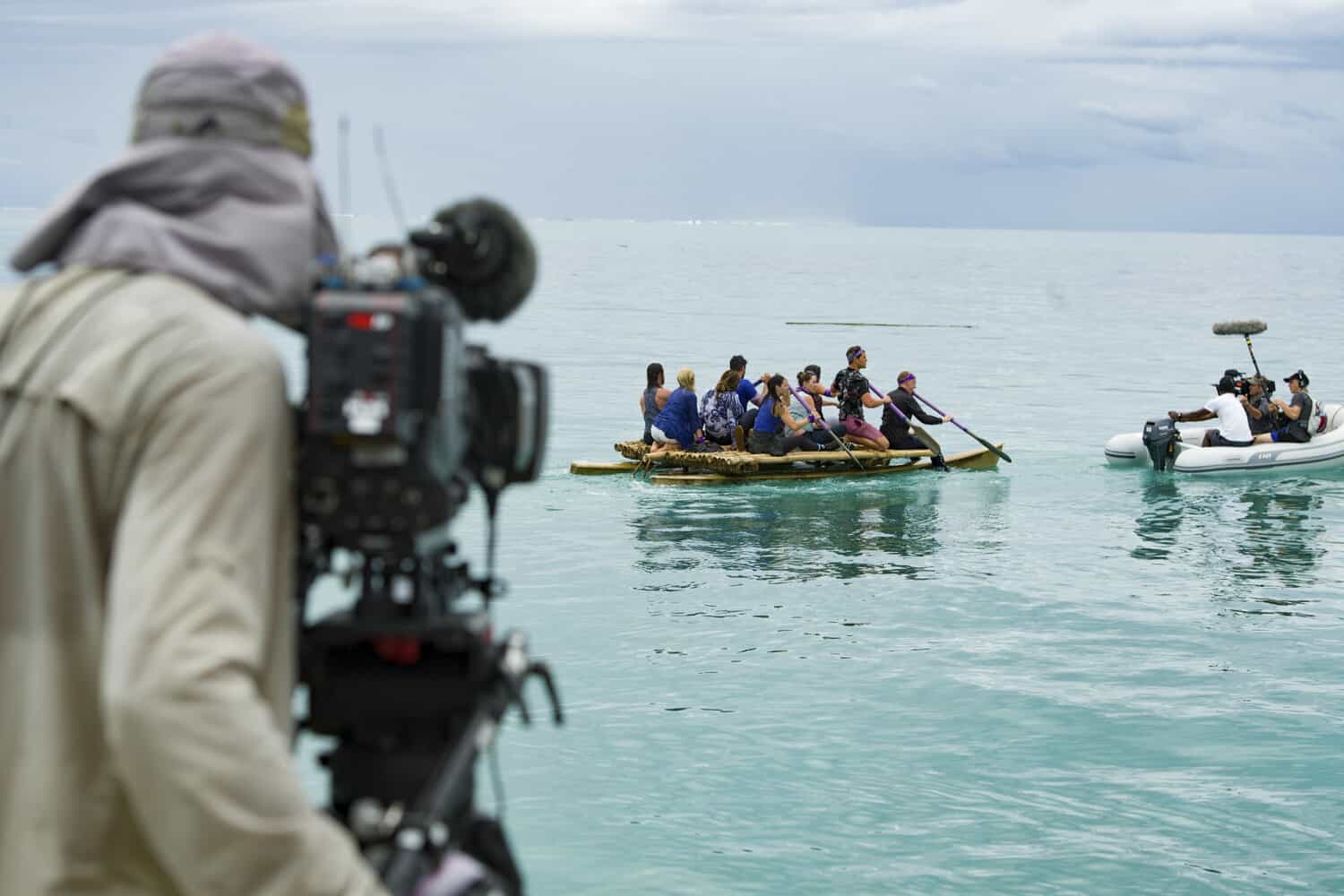
Day 1 on Survivor: David vs. Goliath on the CBS Television Network. Photo by David M. Russell/CBS 2018 CBS Broadcasting, Inc.
I spoke also with challenge camera operator, Efrain Laguna, aka “Mofi.” When asked about his start on Survivor, he shared his tale of when the production came to his country of Panama, “I started in 2003, Season 7. The first job I did, even before starting working as crew on the show, was as a PA driver for the scouting producers that came to Panama.”
Mofi explained, “As the driver, I was offered a job working in the art department but I explained that my thing is camera. So producer Jesse Jensen got me an interview for camera and I did well with the interview. I then got the job as an AC. There were Sony Betacam SP cameras, I was an AC for a few years and became a junior shooter…soon after, I worked in that category also on Love in the Wild with director David Dryden.”
Another Dream Team Survivor career start is Reality camera operator Marc Bennett, aka Benny. When we sat down to talk during another beautiful afternoon in Fiji, Benny had just finished painting a portrait of his boss, DP Peter Wery. It was a very artful rendering of Peter, quite colorful and enjoyable. Benny recounted, “I started Survivor back in 2004, Season 10, as a Dream Teamer, but I went to film school for three years before coming here. I’ve been back every year since, I only left one year to do Amazing Race. That was very frowned upon. But I came back. This is my family.”
Benny continues, “Dream Team rehearses the Challenges before the contestants. I was always an athlete, back in back in those earlier days of Survivor, the Challenges were more physical. I became a Dream Team “All Star” as a result of my performances during the Challenges. I did two seasons as a Dream Teamer, then I got offered a segment producer position, Dream Team coordinator, and then Reality camera AC, all in the same day. I wanted to be a camera operator, so I chose AC. My mother was a still photographer. We had a darkroom in our house. I was constantly developing black and white pictures. I lived most of my high school in a darkroom. There’s nothing more satisfying to me in my life than photography.”
Benny adds, “Survivor is more than a family. It’s my best friends. My real family is in South Africa. They live there, I don’t see them very often. This family is like a true family, we really look out for each other, really want the best for each other, and we constantly push each other to be better. It’s always like that every day shooting on the beach. As you know, you don’t come to work unless you come to work. And if you’re not coming there to work, then you’ll get called out for it. We respect each other. If you had a big night the night before, and you come to work, we don’t care as long as you do your job well. But if you’re not doing it right, then we’ll let you know. We’d have a tough love family but the love is stronger than the toughness. I love my mother. I love my dad. But I would say I love my colleagues more.”
Challenge camera operator Ben Gamble of Los Angeles has a very specific responsibility. He lenses in solely on the Survivor host, Jeff Probst. He has been doing that same job for quite a few years. Ben sums up his experience like this, “My main job on the camera crew is to film Jeff at the Challenges. I love it. The Challenges are always intense. I usually do a lot of live repos to get the best angles. I use the intensity of everything around me to sprint full blast with my camera and tripod. It is very fun.” Ben adds, “My most memorable experiences on Survivor are my days off. I spend almost every day off surfing. Fiji has the best waves I’ve ever seen, and I feel extremely lucky that I’ve been able to work and surf there.”
Ben joins the chorus about the camaraderie on the show, “The Survivor family is why I keep coming back to the show. I’ve never been treated as well on any other production, everyone on the crew becomes a part of the same tribe, and we tackle all of the production challenges together. The tropical storms, the heat, the mosquito swarms, dealing with the unpredictable ocean, conquering all of this really makes our crew grow closer.”
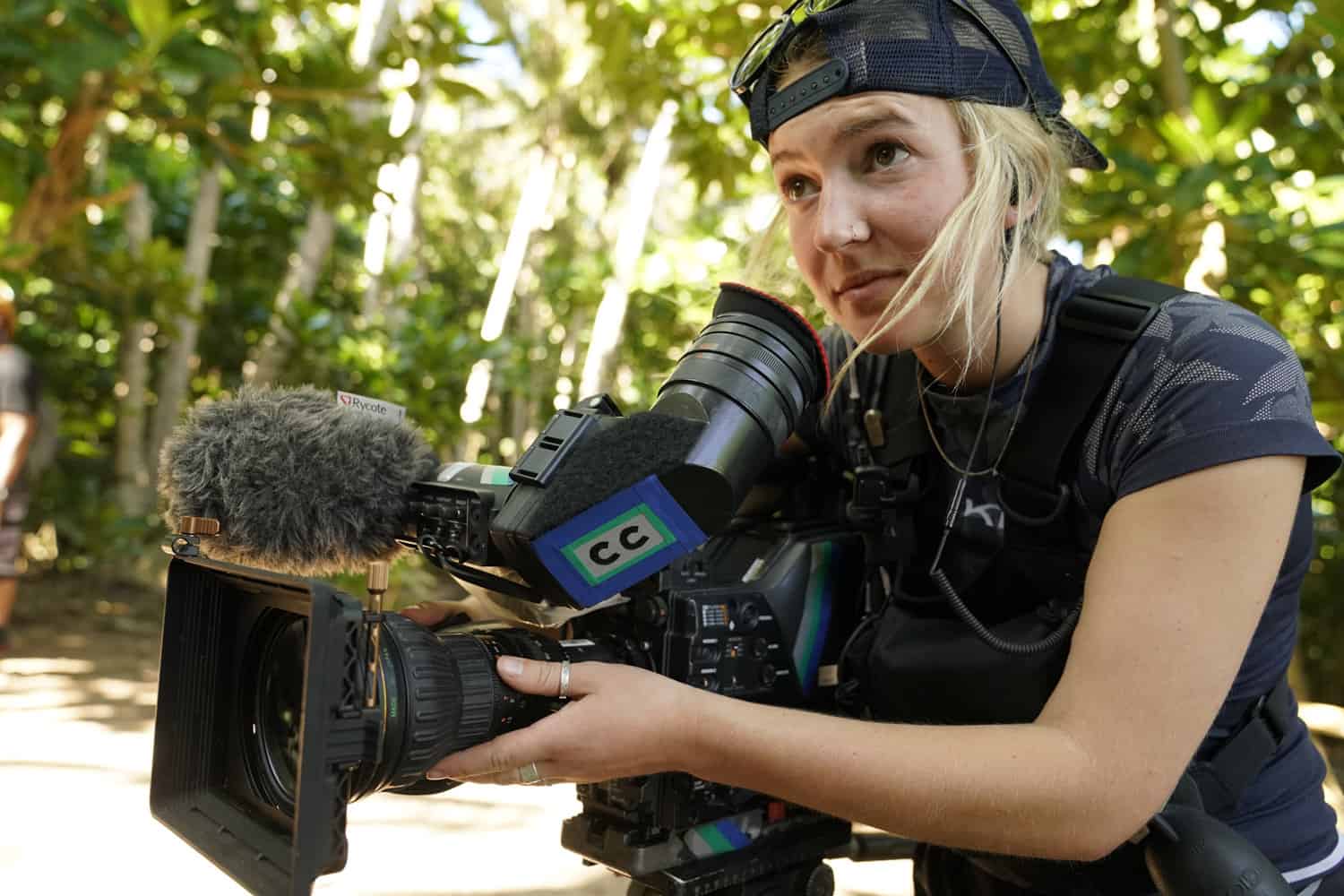
Day 22 of Survivor 42. Photo by Robert Voets/CBS Entertainment 2021 CBS Broadcasting, Inc.
Reality camera operator Rodney Chauvin had this memory of his getting the job: “I started on Survivor Season 14, which was 2007 and the first season in Fiji. I had been working on The Apprentice. One of the producers from Survivor was an executive producer on Apprentice. I always wanted to do Survivor but it was hard to get on as an operator. Every reality camera operator wanted to work on this quintessential show, Survivor. He threw my name in the mix and I got an interview online with the executive producer who wanted me to do an interview in Los Angeles, but I was living in New Orleans and I couldn’t make that happen. So we just did it on the phone, and he said tell me something about why you should work on Survivor. I said, ‘I’m from New Orleans. I work in the swamps and what else to say but I’m pretty tough. You know the state bird in Louisiana is the mosquito.’ He was impressed with that, so I got on the show.”
Rodney continued, “I started off as a film AC and I progressed into operating. There wasn’t a lot of narrative work in New Orleans. There was a reality show called Temptation Island. That was my first big break. I started on Temptation Island, which was shot in Costa Rica. I was hooked. I love the storytelling and reality television was blowing up. It was 2001, I never looked back. I thought I was going to be a narrative guy, but I was really excited about the storytelling, the adventure, and reality television.”
John Tattersall, Challenge camera operator, chimed in about his start, very early in the Survivor history, “I had lived in Australia where I had started in the industry as an AC. I had an agent as an AC, many years before, and later on, when I’d been camera operating in Europe and London. After I returned from working in China, I called her for a catch-up and she said, ‘There’s this weird American show going on, it sounds like a terrible job. Apparently, they’re living in tents in the outback of Australia and trying to make this weird TV show. They call it ‘reality TV’ or something ridiculous. I know from all everything I can hear, it just sounds awful, but that’s the only thing that is going on. I’ll send them your contacts and CV.’”
John continued, “The guy who was directing Season 2 at the time, Cord Keller, was very interested by my CV because I had a picture of myself in the corner. He thought I was a singer from one of his favorite bands. He actually mistook my picture. However, it got me a phone interview. He wanted to have me on as DP for the show. At the end of this two-hour strange conversation, he said, ‘So you’re about my age at about 49.’ And I said, ‘No, 29.’ Then there was this awkward silence. Then he said, ‘Oh, okay. Yeah, yeah. Okay, great. Great. You know, we’ll—I’ll call you, I’ll call you.’ He hung up and I just knew that he wasn’t going to call.”
John adds, “Weeks go by, and all of a sudden, I get an e-mail, in the early days of e-mail, with my plane ticket to Cairns in Northern Australia, Queensland, for this job. There is no work explanation just the plane ticket and instructions for travel. So I got on the plane and flew to Cairns, got on a secret bus filled with a bunch of camera operators that were all flying in from different parts. No one knew each other. We had a six-hour drive into the outback of Australia—into this beautiful, remote wilderness area of gorgeous mountains. I turn up in the evening, and there was a sea of tents, as far as the eye could see, hundreds and hundreds of little dome tents. And it looked just like a music festival. You can imagine, I was really confused at this point. I didn’t know what was going on.”
John adds, “I walked to my tent, went to bed. That was my first night on Survivor. The funny little ending of that story is in the morning, I woke up, unzipped my tent and there was a guy unzipping his tent in front of me. He did this double take, he looked at me, and I said, ‘Donald?’ and he said, ‘John?’ as we were both schoolmates in England. He said, “What are you doing?” I said, “I don’t know, what are you doing?” He had been traveling, backpacking, he was picking fruit. He had seen an ad posted on a billboard somewhere that said they were looking for ACs. He’d been an AC in London, but he’d taken a year off to just go traveling. We were friends at school, we kind of lost touch and it was so great to see him, and we reconnected. He became my AC, and instantly we were friends again. This is before social media, nobody knew what each other was doing. We really had this genuine surprise. Then I went to my first whiteboard meeting and started my first season on Survivor.”
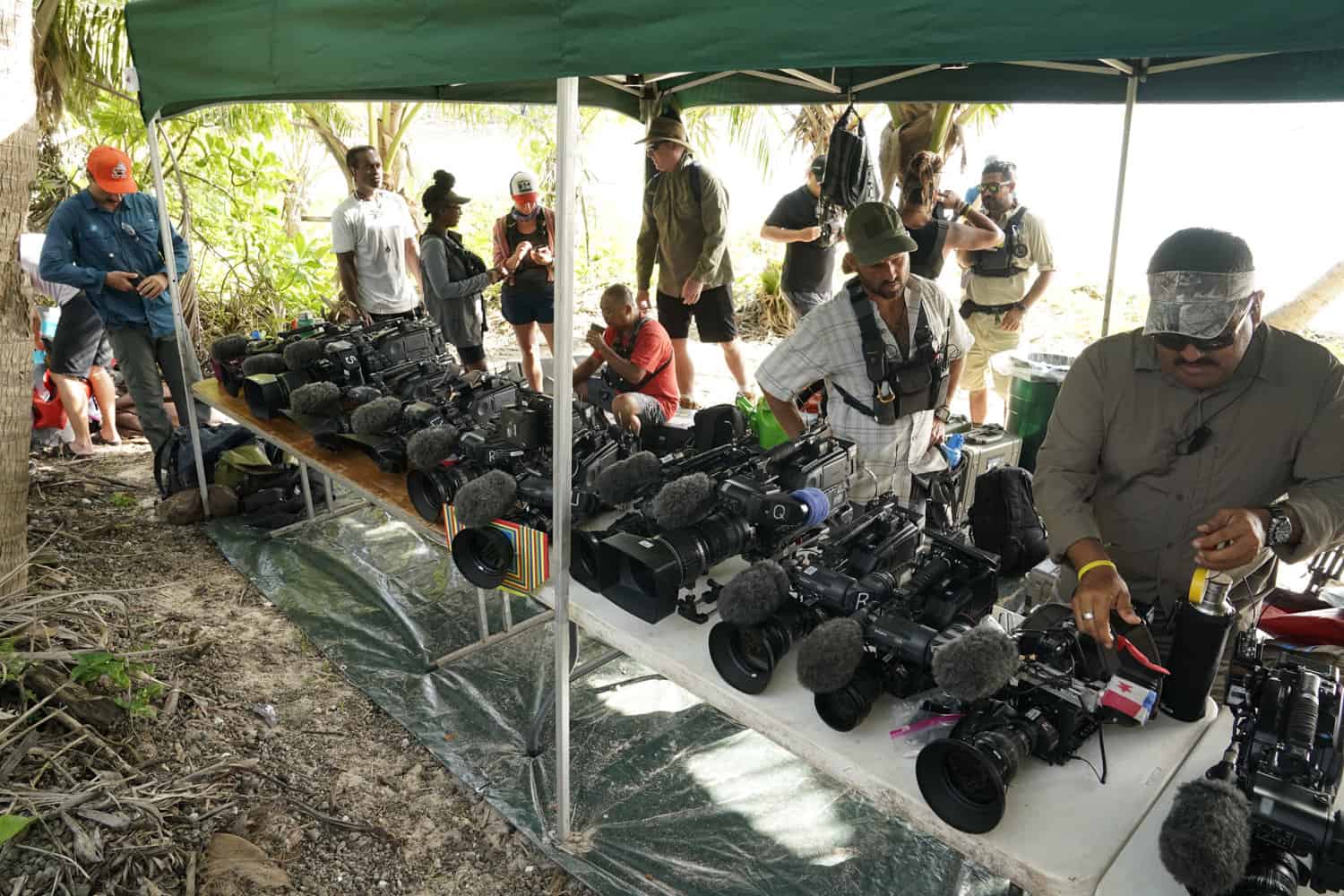
Survivor S42 Challenge camera prep tent. Mofi Laguna (far right) as AC Pedro Zinago observes. Photo by David Frederick, SOC
Matthias Hoffman is a Reality camera operator who is an Austrian living in the United States. I asked him his Survivor history. “I started Survivor in 2001, working 40 Seasons, 20 years now. I started on Episode 3 in Kenya, Africa. I keep coming back because it’s something that’s no other show has, it’s kind of a family. It brings you to interesting places, you have time to meet the local people and learn a little bit about their culture. You have time to spend in a place that you would normally probably never go to, or maybe pay a lot of money to get there. It’s work and you earn money, have good friends with me. You work hard. What I do is hard. I’m now 54. I’m an old man.”
He continues, “The Survivor family is a lot of personal connections that I made along the way, it became an important family to me, away from my real family. I met my wife on the show, we both worked on the show, she is the mother of my youngest son, Lucas. I have two additional sons from a previous marriage. One son, Kenny, is also working on Survivor. This is his seventh season. He started in Fiji on Dream Team, then showed some interest in segment producing, but that wasn’t his thing. He then slipped more into the technical department. He started liking camera, like me. Kenny was hired as a AC in Challenge, he also works on the drone and cablecam team. He sometimes gets to shoot additional camera on the challenges.”
Matthias added, “Having the opportunity to work with my son on this show is like a dream come true. I never really told him to do what I do. It just fell into place and it’s awesome. There was a time, in the past, when I started Survivor, 20 years ago, I was going through a divorce and Kenny and his brother went to America from our home in Austria. That was a really tough time for me. Now, it has come full circle, which is really cool. So he’s back here with me, and it’s an awesome feeling.”
“Today, I had a B-roll day. I was sent out to one of the big surf breaks to film waves in slow motion. So I did some above water. I grabbed a GoPro in an underwater housing and then went into the waves and filmed them breaking and all that turmoil on the waterway. It was pretty awesome. It was a great day. I like surfing. So for me it’s an amazing reward. So yeah, I didn’t get to surf today, but I got to film it so other people could enjoy it.”
Being curious for his perspective as one of the earliest camera operators of the show, I asked Matthias about his work on the reality crew. “In reality, the hard work is when you’re out on the beach and filming the contestants. Whatever they do, you backtrack all day on your feet, you carry a camera that feels like it weighs a ton. It is like having a little child on your shoulders, about 10 kilos. That’s the hard part. You get through that, and then still want to maintain a quality in your footage, show really interesting stuff, and make beautiful pictures. I think when you watch the show, you see what is actually happening. So this is the challenge. You do 10 hours a day out there, and it’s more like 15 hours on a normal day, sometimes more. It’s pretty rough out there. There’s not a lot of stick time, which we call time on the tripod, which we do have, but a lot of time the contestants walk away and we lead them walking backwards. We keep the shot steady on a 20-by zoom, which is not that easy, but it’s beautiful because you can pan from one to another. It’s not just a wide shot of people walking through the forest. So yeah, that is the challenge. And that’s also sometimes taxing and hard.”
Matthias joins up on Challenge shoots. “Getting to work some days on Challenge is kind of a break. You see how other people work, you see how Challenges are being operated. I think it’s fun, it breaks up the day, and gives us all a little bit of a different view of the whole game. If you don’t see that part otherwise, you see people strategizing out on the beach, but you don’t see them compete. So they come back, somebody won, you hear a story, but you never really see it. So that’s kind of cool to be part of that. It’s a different challenge.”
On screen direction, Matthias offered up this scenario: “You have to shoot for the editor. If you think like an editor—which is another piece of advice—if you want to get into this game you should edit before you come to shoot. I think it helps you understand what the person that sits in the dark room later will experience as it is very different to what you experience on set. So you have to shoot for them. You have to give them footage that they can put together easily.”
“In filming reality, you think, how do I make it transition in a conversation not to break the screen direction line or the side that we’re shooting on? How do I make a transition so we can use that? Make it so that the editor can use that transition in the edit when you have to go from one side to another. You think about reestablishing the 180 line. Sometimes you must break it because the contestants break it and turn around. If they change their sides and directions, and we’ll open up let them walk. And you watch how it ends up. They’re fine, perfect, okay, nice, we will shoot from there. It’s just a matter of thinking ahead of what can happen. That’s something you have to learn, and to work with the other cameras. You may have two other cameras that you have to shoot a whole scene with and you have to coordinate with them. We don’t talk much, we just dance around, it goes from this side to that side. You just look with an eye open and we dance around the fire.”
Interview with Survivor Director David D. Dryden
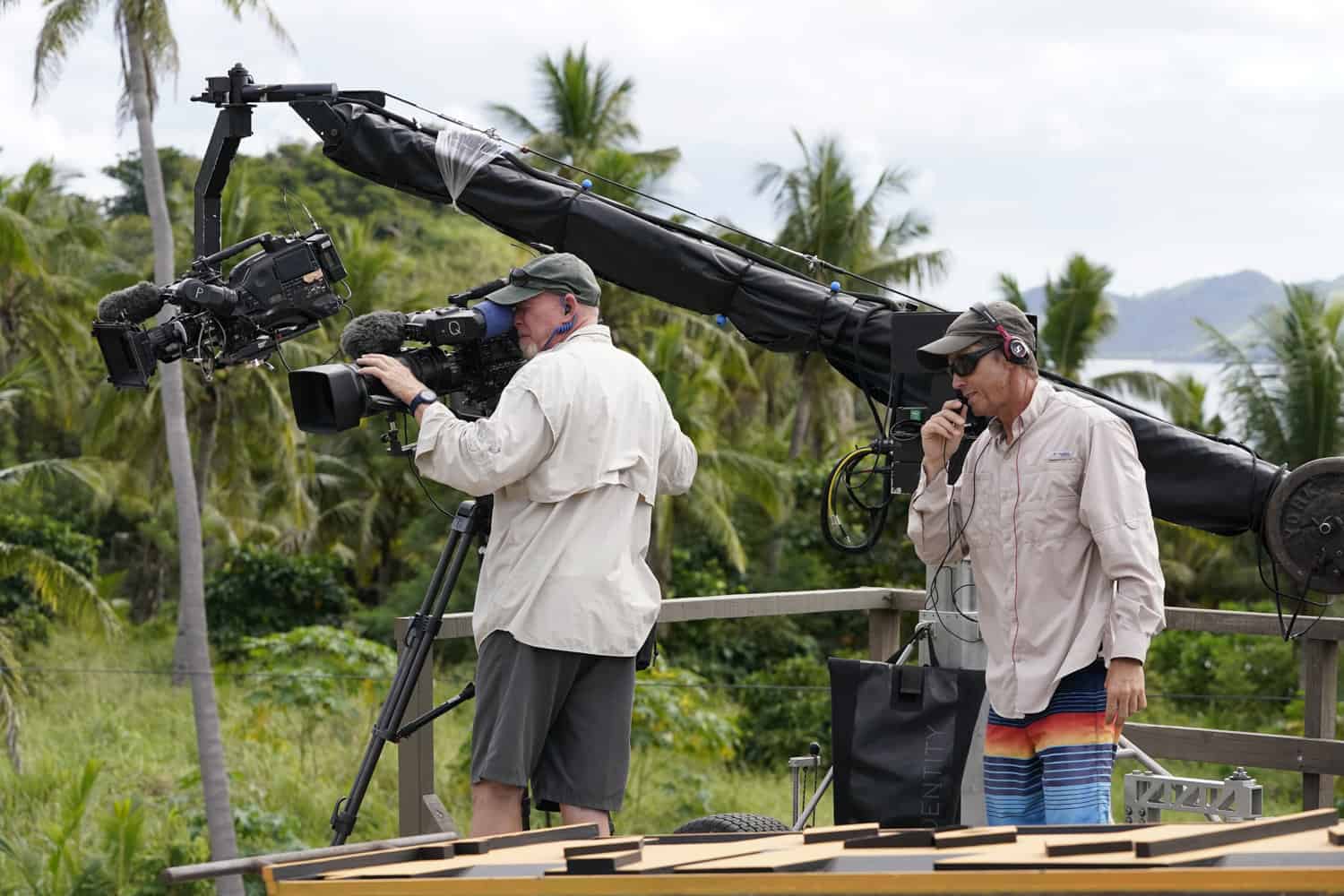
Survivor S42 Challenge long lens operator Kevin Garrison and director David Dryden. Photo by Robert Voets/CBS Entertainment
David Frederick, SOC: How long have you been directing Survivor?
David D. Dryden: The first season that I directed was Season 7, The Pearl Islands, in Panama. The rest is history…a lot of mine…in so far that I have remained the director of the show since then and now have finished Season 42, making my grand total of 36 seasons of directing Survivor. I started on Season 2 of Survivor, The Outback in Australia. And I was 2nd unit director for the following four seasons. I took over directing after Season 6, which was the Amazon.
Frederick: How did you begin on the show?
Dryden: I was living and working in Australia at the time. I was an assistant director on a popular television show in Sydney called Water Rats that was similar to CSI in the United States. Our production shut down during the 2000 Olympics. I ended up working on Bud Greenspan’s film, Sydney 2000: Stories of Olympic Glory, as a venue producer. There was a long lull between the Olympics and when productions started up again in Sydney and a friend of mine from Water Rats got a job as a production coordinator on Survivor, which was shooting their second season in Queensland, Australia. She brought me on as the “night tape librarian,” logging footage as it was turned into postproduction. So, I was actually hired as an Australian. I got to know many key figures on the show and when I returned to the United States, I started working for the then-current director, Cord Keller. After working with him on Mark Burnett’s show Combat Missions, he brought me back on Season 3 of Survivor: Africa, as the 2nd unit director.
Frederick: What is your notion of the “Survivor family?”
Dryden: You hear the term “Survivor family” a lot in relation to the Survivor experience. The reason is multifaceted. But there is definitely a trickle down effect. Jeff Probst has been at the helm of the show for a very long time. His leadership, commitment to excellence, and supportive nature have nurtured the notion that we are all a family working together to make the best show possible. Couple that with the fact that many of us have worked together for over 10 years, and that is on the low end of the spectrum. Many of us have been on the show for 20 years. Additionally, we spend many months in a row a year, away from home, and often away from our families. I am very lucky in so far as my family has always been able to travel with me on the show (again that is thanks to Jeff). However, the point remains that, year after year, we get to work and live together in a foreign county and have been doing it for many, many years. There is a bond that develops over time, where like-minded people are giving everything they have to create the best show and work environment that they can. And, we have been doing this together for a really long time. I really don’t know any other environment which is more like a family, where you care so much about each other and the purpose that you all serve together.
Frederick: What is different about directing Survivor?
Dryden: Once aspect of Survivor that is different from many of the other shows that I direct is that when we are in the field shooting Challenges, I do all of my directing by “line of sight.” There are no monitors, no control room, no way of me seeing exactly what the operators are shooting. Tribal Council is different, I have a standard control room and can see all of the operators. However, on Challenges, I do all of my directing based on how I have deployed my operators, what assignments I have given them, and what I observe based on what is happening. I cannot see any images of what they are actually shooting. This kind of directing is based on a tremendous amount of trust and in field communication, and I feel the results are even better than when I am trying to micromanage 15 shots at a time based on watching what they are shooting on a monitor. I am much more connected to the overall action and the story that is unfolding, and I am able to direct them into the best position to capture the “story” that is unfolding at the macro level. This system only works because of the extraordinary talent and abilities of the camera operators that I get to work with on Survivor. I feel that my job is to lay out the best plan possible, and then try not to get in their way of executing it, while communicating information to them from their blind spots that they cannot see directly through their eyepieces. The system has worked flawlessly for 20 years, though I have found it very hard to replicate on other shows.
Frederick: Are there any additional contrasts for you between the Challenges and Tribal Council as a director?
Dryden: Insofar as I direct Challenges without a control room, Tribal is very much the opposite. Additionally, Challenges are shot in daylight and Tribal is shot at night on a fully lit set. There is a lot more involved in set design and lighting that goes into Tribal Council. Because of that difference, we can usually rehearse a Challenge and then be in a very good position to shoot the live event with a few adjustments. For Tribal Council, we are dependent on checking and rechecking lighting and technical aspects of the shoot every time that we shoot a Tribal Council in order to maintain consistency of the look. If there is one thing that you can count on when you are shooting on an island or in a jungle, is that everything has changed a bit when the elements are heavily involved.
Frederick: Has any new technology made your job as a director better?
Dryden: I have to say that the developments in technology are constantly making my job as a director better. There are more tools at my disposal now than ever before, such as drones, GoPros, low-light cameras, 360 imaging, etc. As technology advances, so do our opportunities to get new looks, new shots, new angles, and better coverage. I used to spend hours in the helicopter shooting Cineflex, and now we can get similar shots in a couple of minutes, or even during a Challenge, with the use of a drone. Technology creates new opportunities to be creative and to ask ourselves, what more can we add to our show and how can I tell this story in a fresh and compelling way?
Frederick: Any advice for someone who might be interested in working their way up to direct a show like Survivor?
Dryden: Well, if you can take anything away from my own experience, it is that anything is possible. I started as the night tape librarian on Survivor and now I have been the director of Survivor for almost two decades. The advice that I could give would be to be curious and to learn as much as you can about every aspect of whatever it is that you are surrounded by. I did not set out to be the director of Survivor, but I was intent on learning everything that I could about how amazing the show was and how it was put together. The quality of the product, the sense of family, the work ethic, the love, and pride that motivated everyone to do the best that they could to make the show better, was always an inspiration to me and made me want to be a part of it. Survivor the show, and the people who dedicate so much of their lives to making it the amazing show that it is, has been an inspiration to me and my love of being a part of this amazing journey.
Camera Operator Fall 2021
Above Photo: SURVIVOR S42 Challenge camera operators on scaffolding in 40 feet of water. At right is author David Frederick, SOC.
Photo by Robert Voets/CBS Entertainment
TECH ON SET
Camera and support equipment supplier: PRG Gear, previously VER
30+ SONY F-800 XDCam Cameras
Canon 40x, Fujinon 21x and 28x lenses: Arri Alexa (Scott Duncan)
RED Monstro Camera (Russ Fill)
Cablecam with a Sony FX3
4 DJI Drone Cameras
Sony IR cameras (night segment producers)
2 Stanton Triangle Jibs
BEHIND THE SCENES
Select Photo for Slideshow
David Frederick’s credits on film and TV series as a cinematographer include The Society, Get Shorty, Muppets From Space, The Soloist, Northern Exposure, Aquarius, The Bridge, and Sons of Anarchy. Currently, Dave is on location in Budapest, Hungary, working as the alternating director of photography on the new Dick Wolf series for CBS, FBI: International. Frederick shoots with every camera and format of film and digital, “There is always a story to be told with a camera. Perhaps it’s a lavish epic captured with remote heads, cranes, helicopters, Steadicam, U/W, gyro rigs or large format anamorphic cameras, or I can film handheld, with the latest small professional digital camera. The ability to share my passion and joy of filmmaking with the director, actors, and crew on any film set is what gets me out of bed in the morning. When I encounter a story rich in integrity and humanity, I thrive on bringing it to life through the lens.”
